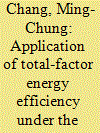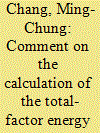|
|
|
Sort Order |
|
|
|
Items / Page
|
|
|
|
|
|
|
| Srl | Item |
| 1 |
ID:
176801


|
|
|
|
|
| Summary/Abstract |
As the computation of total-factor energy efficiency (TFEE) is not workable under the metafrontier framework since the metafrontier cannot fully envelope each group frontier, this research provides a new computation mode to solve this problem. Following a discussion on the methodology, we conduct empirical analysis on 28 member countries in the European Union (EU) and then divide them into Baltic sea region (BSR) countries and non-Baltic sea region (NBSR) countries for metafrontier analysis, thus contributing to the literature by presenting an available mode for TFEE analysis under the metafrontier framework. The suggested mode herein operates so successfully that all computation scores exhibit a reasonable scope. In addition, the BSR's average energy efficiency performs better than NBSR's, but the latter is still a technology exporter compared to the former. This paper summarizes the conditions for sustainable energy development: (i) set more serious energy efficiency targets; (ii) reduce primary and final energy consumptions, lower energy dependence on energy imports, and increase the share of renewable energy sources to fossil fuel energy sources; (iii) achieve a liberalized energy market; and (iv) set reasonable energy prices by levying an energy tax in order to realize effective energy consumption.
|
|
|
|
|
|
|
|
|
|
|
|
|
|
|
|
| 2 |
ID:
117348


|
|
|
|
|
| Publication |
2013.
|
| Summary/Abstract |
This study provides a no-output growth model to conveniently calculate the total-factor energy efficiency (TFEE) index originally proposed by Hu and Wang (2006). The TFEE index serves as a very well-known and popular means of estimating overall energy efficiency. While many previous studies have used the indicator of energy inefficiency, including the indicator of energy intensity (i.e., Energy input/Gross Domestic Product (GDP)) to measure energy efficiency, Hu and Kao (2007) point out that the indicator of energy intensity is not only a partial-factor energy efficiency indicator, but that this partial-factor ratio is also quite inappropriate for analyzing the impact of changing energy use over time. The TFEE index overcomes the disadvantage of the indicator of energy intensity as mentioned above, but five steps are needed to calculate the TFEE score. In this study, we provide a no-output growth model to conveniently calculate the TFEE score. Furthermore, we extend this no-output growth model to an output growth model. This study concludes that the output growth model not only makes it easier to calculate the TFEE index than the model proposed by Hu and Wang (2006) and Hu and Kao (2007), but that it can also obtain better TFEE scores.
|
|
|
|
|
|
|
|
|
|
|
|
|
|
|
|
| 3 |
ID:
128412


|
|
|
|
|
| Publication |
2014.
|
| Summary/Abstract |
While the previous literature shows that a decline in energy intensity represents an improvement in energy use efficiency, it does not provide a target level of energy intensity, nor what room for improvement in terms of energy intensity could entail. This study establishes an indicator of such room for improvement in terms of energy intensity by measuring the difference between the target level of energy intensity and the actual energy intensity and thereby monitors energy use efficiency. The traditional indicator of energy intensity, defined as energy use over GDP, mainly estimates energy use efficiency, but is a partial effect between the energy input and GDP output. However, our proposed indicator of the room for improvement in terms of energy intensity is the total-factor effects based on the multiple-inputs model. By taking the 27 EU members to investigate their energy use efficiency using the indicator of the room for improvement in terms of energy intensity, this study concludes that an improvement in energy intensity does not fully depend on a decline in energy intensity, and we instead need to confirm whether the room for improvement in terms of energy intensity decreases. This finding is particularly relevant for energy policy-makers.
|
|
|
|
|
|
|
|
|
|
|
|
|
|
|
|
|
|
|
|
|